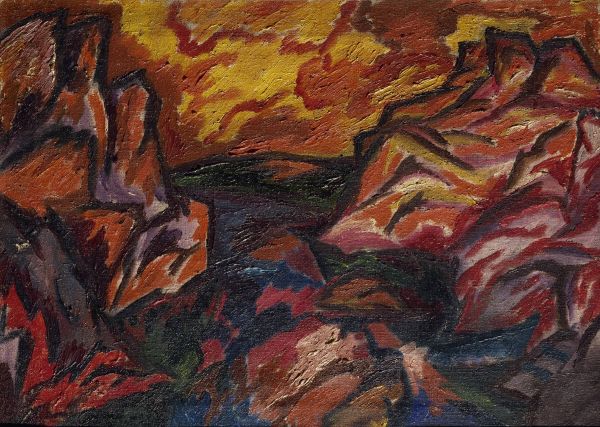|
|
Rapids on the Dniester. Early 1910s

Burliuk David,
Oil on canvas
49 х 69,5
State Russian Museum
Пост. в 1985, дар семьи Б. Н. Окунева, Ленинград
Annotation
In Burliuk’s works, one can sense the same enthusiasm and the same powerful energy that everything he did was imbued with. His characteristic unrestrained “internal” force burst onto his painted canvases, his own theoretical constructs notwithstanding. Varying the possibilities of paint, from painting in thin layers, when the canvas is just “rubbed” with the brush, to powerful convex strata upon which he laid grooves in relief, like in Rapids on the Dniester, Burliuk seemed to illustrate his own statement “Before painting saw, and now it touches” with his canvases.
Author's Biography
Burliuk David
Burliuk, David Davidovich (1882, Semirotovshchina (Kharkov Gubernia) — 1967, Long Island, United States)
Painter, graphic artist, book illustrator, poet, author of manifestoes, critic. Studied at the Kazan School of Art (1898–1899), Odessa School of Art (1899–1901, 1910–1911), at the Königliche Akademie der Künste in Munich (1902–1903), Fernand Cormon’s studio in Paris (1904) and at the Moscow School of Painting, Sculpture and Architecture (1911–1914, expelled together with Vladimir Mayakovsky). Contributed to the exhibitions of the Union of Russian Artists (1906–1907), Fellowship of South Russian Artists (1906–1907), Exhibition of Modern Trends in Art (1908), Golden Fleece Salon (1909), Union of Youth (1910–1912), Der Blaue Reiter in Munich (1912), Der Erste Deutsche Herbstsalon (1913), Salon des Independants (1914), Knave of Diamonds (1912–1916, one of the organisers of the first exhibition in 1910), World of Art (1915, exhibitor). Lived in Japan (1920–1922) and the United States (from 1922).

